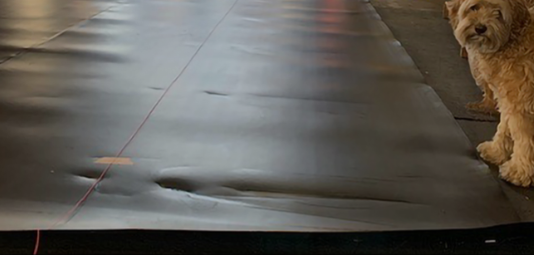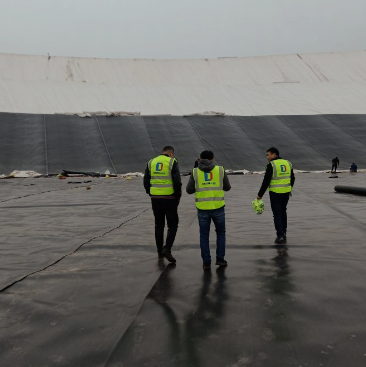- Understanding the Role of Geomembrane Liners in Waste Management
- Innovations in Geomembrane Liners for Water Management
- Geomembrane Liners: A Comprehensive Guide
- The Future of Geomembrane Liners in Civil Engineering
- Geomembrane Liners: Enhancing Landfill Stability
Manager:Alvin Wang
WhatsApp:+62 8983806051
Tel:+86 10-5797-1075
Email:steelwang@okorder.com
Address:3rd Floor, No.2 Building, No.1 Sanlihe Road
What is better than HDPE geomembrane?
hdpe Geomembrane has a long been considered as a dependable and versatile material for various containment applications in civil engineering and environmental projects. It is an ideal choice for lining landfills, ponds, reservoirs and other structures where the containment of liquids or gases is required due to its durability, chemical resistance and impermeability. However, with the advancement of technology and the coming forth of new materials there is the question: What is better than HDPE geomembrane? This article looks into alternative lining materials that have additional advantages over HDPE geomembrane.

Understanding HDPE Geomembrane
It is important to understand the properties and characteristics of HDPE geomembrane before looking at other alternatives. High density polyethylene (HDPE) geomembrane on the other hand refers to a synthetic liner made from high-density polyethylene resin. This thermoplastic offers excellent resistance to chemicals, mechanical strength as well as flexibility which makes it suitable for wide variety of containment applications.
Challenges with HDPE Geomembrane
Despite being widely used and appreciated for its performance, however, HDPE geomembrane does not lack shortcomings or issues. Some common problems associated with HDPE geomembranes include seam integrity issues, susceptibility to UV degradation; potential leaching out of contaminants as well as temperature limitations. These drawbacks have prompted researchers and engineers to explore alternative materials that might offer better performance at lower costs in certain instances.
Alternative Lining Materials
A number of different lining materials are now available which have found use in containment systems where their propertiesoffer significant differences from those of HPDE geomembranes.Others are;
1. pvc geomembrane
This flexible plastic liner made from polyvinyl chloride resin known as Polyvinyl chloride (PVC)geomembrance may offer improved uv resistance compared with hdpegeomembrance while having similar chemical resistance levelsand flexibility. Furthermore, this liner is often found in more thicknesses and colors, thus making it easier for customization and enhancing its appearance.
2. EPDM Rubber
Ethylene propylene diene monomer (EPDM) rubber is a synthetic rubber famous for its superior elasticity, weatherability and flexibility. They include but not limited to pond liners and roofing membranes that require high elongation at low temperatures. Though this material may be more expensive than HDPE geomembrane, its extreme flexibility as well as elongation make it suitable under difficult installation conditions.
3. Composite Geomembranes
Different materials can be used to create a composite geomembranes which combine multiple layers so that their different strengths can be fully exploited by each component. For instance, a geotextile fabric or bentonite clay may be bonded to HDPE or PVC layer in case of a composite geomembrance. These are known for better puncture resistance, filtration capacity and sealing ability when compared with single-layer geomembranes. Although the cost of these composite geomembrances may seem higher at first they help to reduce the expenses on additional geosynthetic materials in long run.
4. Concrete and Clay Liners
In some cases, conventional materials such as concrete or clay might offer better performance than synthetic geo-membranes.Concrete liners are structurally stable and durable enough for containment structures like reservoirs, channels among others.Clay liners have inherent impermeability plus self-sealing properties making them reliable barriers against water and gas migration.Concrete and clay liners however demand thorough site preparation and installation expertise hence they become dependable over time specifically within such environments.
5. Advanced Coatings & Linings
Coating and lining technologies are advancing, thereby informing containment solutions. For instance, polyurea coatings that have fast curing rates, high flexibility and are resistant to chemicals is applied on top of them that makes them suitable for secondary containment and corrosion protection. Similarly, spray-applied geomembrane (SAG) systems provide seamless, monolithic coatings that conform to irregular substrates and offer excellent resistance to chemicals and abrasion. However, these advanced products may be more expensive than conventional geomembranes but they will outperform them in the demanding environments.

Conclusion
However good HDPE geomembrane is for containment purposes; there exist other materials of linings which offer unique benefits and operating attributes that fit certain project specifications. Selecting a liner material as well as PVC geomembrane, EPDM rubber, composite liners or advanced coatings requires engineers and project stakeholders to consider several options. By analyzing aspects like longevity, cost effectiveness or eco-friendliness; the right product is established. The response to the question “What’s However better than HDPE Geomembrane?” depends fully on each specific case’s requirements or priorities.
-
2024-12-05Geomembrane Liners: A Comprehensive Guide






